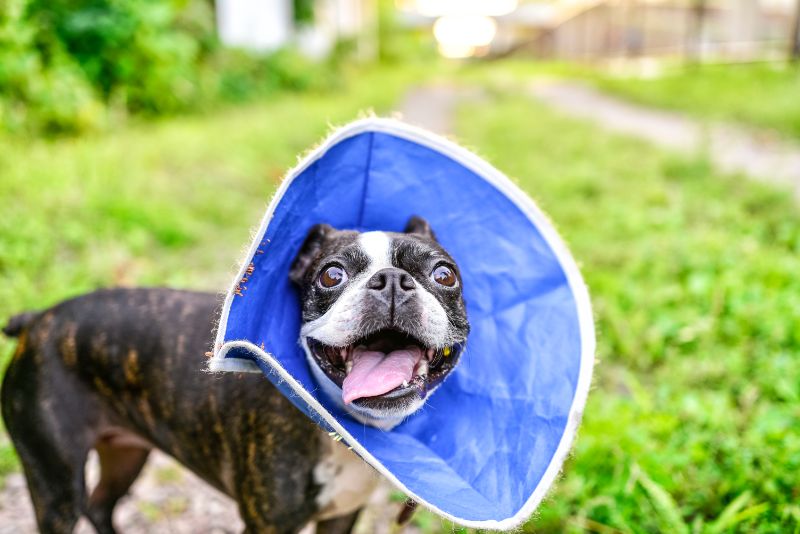Exercise and Entertainment After Your Dog Has Surgery

Exercise is not only important to a pet’s physical health, it is also a great way to reduce negative behaviors and encourage enrichment and enjoyment.
After a surgery, however, your pet will be naturally limited to how much and what kind of exercise they can participate in. For minor surgeries, your veterinarian may instruct you to start your pet walking or other form of movement after a day or two, while more major surgeries might require immobilization for some time.
The team at Volunteer Veterinary Hospital knows how important following guidelines after surgery are, in order to prevent injury and encourage better recovery. This is why we are here to offer a few exercise suggestions for the recovery time after your pet has surgery.
Follow Our Instructions and Ask Questions
After a surgery, you will receive detailed instructions on how to care for your pet for optimal recovery and healing. Whatever surgery your pet has had will determine the type of exercise they can do and what to avoid, as well as other recommendations for increasing the amount of time exercising each day.
Most pets, except those who must be immobilized, are encouraged to walk around the home a bit as well as to go outside to potty, generally within the first 48 hours. Never overdo it when it comes to your pet’s exercise during this critical time of healing.
If you have questions about the instructions, please ask! Even if you need to call, we would always rather clarify our instructions than risk your pet injuring themself during the healing process.
Post-Op Entertainment and Fun
Your pet may not be able to be a star athlete after a surgery, but they can still have fun with you. Choose some challenging games for your pet from the following options.
Sniff, Snarffle, and Hunt
These games are popular for pets who love to root around and nose out delicious treats. Hide a few treats or favorite toys around their crate, bed, or in your hands so they can sniff them out and snarffle them up.
Treat dispensing puzzles like the Brick Puzzle Game and Hide-N-Slide are great brain games that slow your pet’s gobbling tendency down. It takes some time for your dog to figure out how the puzzle works, which can help them wile away some hours during recovery.
Chew Toys
Chewing is a good, and therapeutic, form of enrichment that releases endorphins in the body. Licking, for some dogs, also provides stimulation, enjoyment, and helps soothe anxiety.
Here are a few of our favorite options.
- Licky mats – These mats are designed to have a small amount of yogurt, peanut butter, wet food, or other pet-friendly product spread across it for your pet to lick off. Snuffle mats are especially useful for pets who enjoy licking, because the act of licking increases endorphins and gives them something to do. Bonus, many mats can be stuck to a wall, encouraging standing (and staying!)
- Kong toys – Fill your pet’s Kong, or other fillable chew toy, with peanut butter, mashed banana, pureed pumpkin, or Kong fillers. This will help keep them busy over several minutes as they work to release the goodies inside. You can also sneak your pet’s medication, if need be. For a bonus, freeze the treat-filled toy so it lasts longer or provides a cool treat on a hot day!
- Nylabones – If your pet needs to maintain their weight, a yummy no-calorie choice is the Nylabone. Nylabones are not edible but taste like they could be, since they are usually flavored with something that piques your pup’s taste buds.
- Frozen treats – Both cats and dogs enjoy frozen tuna treats, watermelon or strawberry flawed popsicles, and other pet snacks you can make. Just search online for great recipes for your pet.
New Toys!
Another way to give your pet some exercise is to ditch the old, worn out toy collection and add some new ones. Stuffed squeaky toys are fun for most dogs, as well as tug of war ropes, hide-and-seek games, scratch posts, cat cubes, and whatever seems to get your pet’s attention.
Passive Range of Motion Exercises
These exercises are usually done by a professional veterinary rehabilitator, but you can modify some of these sustained and repetitive exercises at home. Try some of the following, with your veterianian’s approval and once your pet has healed from their surgery.
- Walking
- Using a treadmill
- Swimming
- Walking in a circular motion
- Backing up down a hall
- Sitting down, then up, and repeat
- Lying down, then up, and repeat
These exercises are especially useful when a pet needs to develop muscle strength and improve joint and ligament function.
Other Activities After Your Dog Has Surgery
There are some great modalities that can help improve a pet’s strength, stamina, and ability to heal after surgery. Acupuncture, therapeutic massage, laser therapy, and other alternative therapies can encounge faster and more successful recovery for your special friend. Please call us with any questions, or to schedule an appointment.

